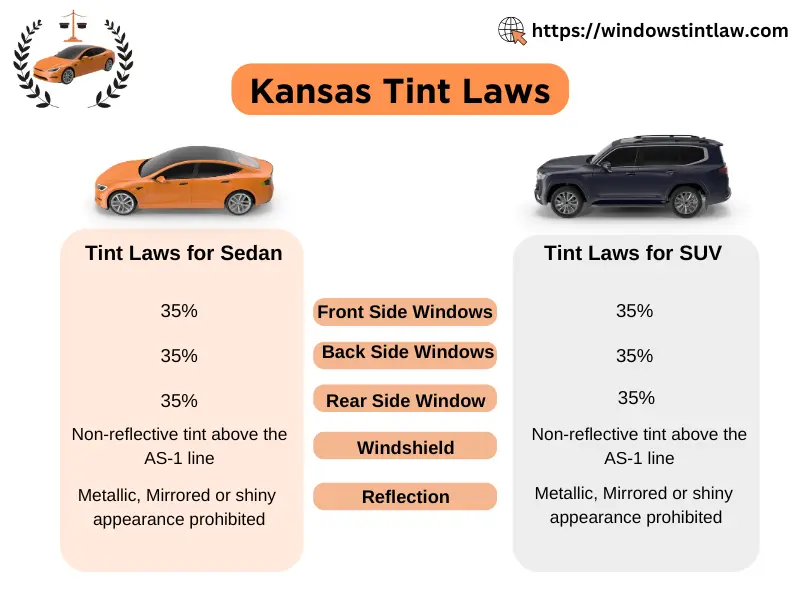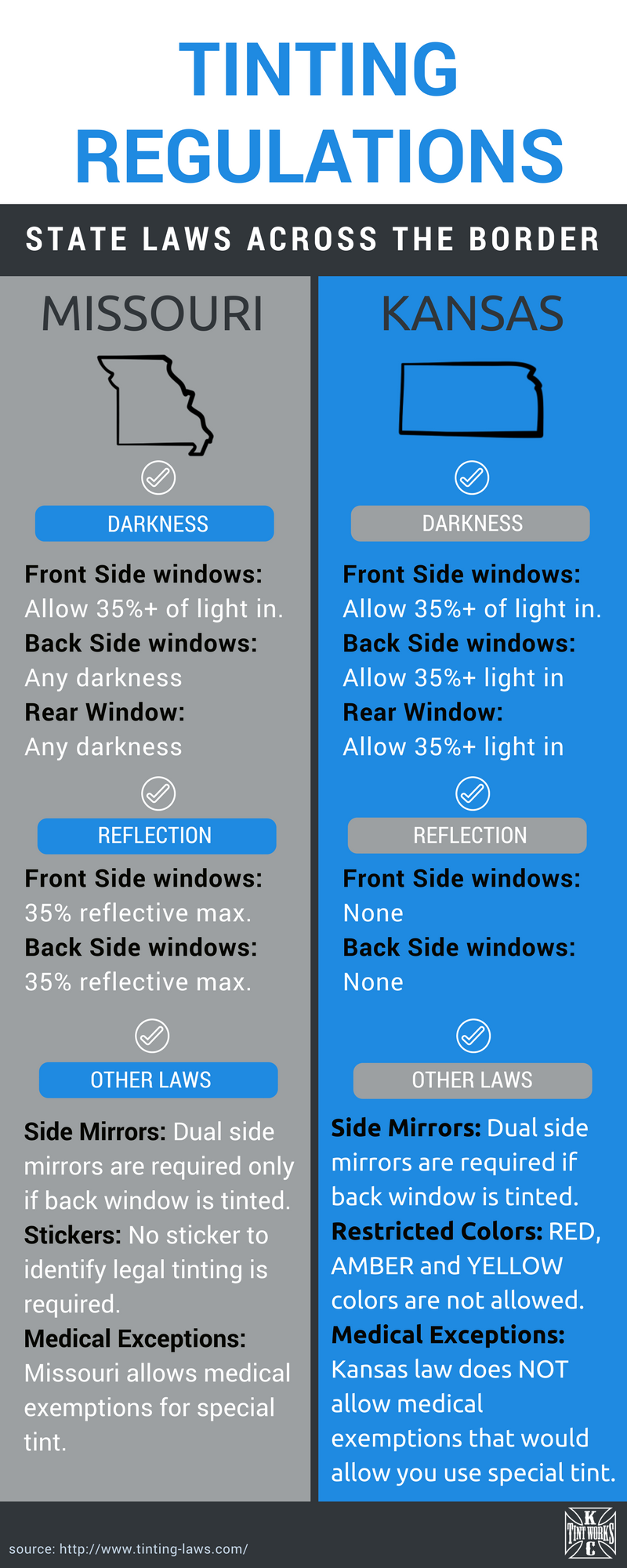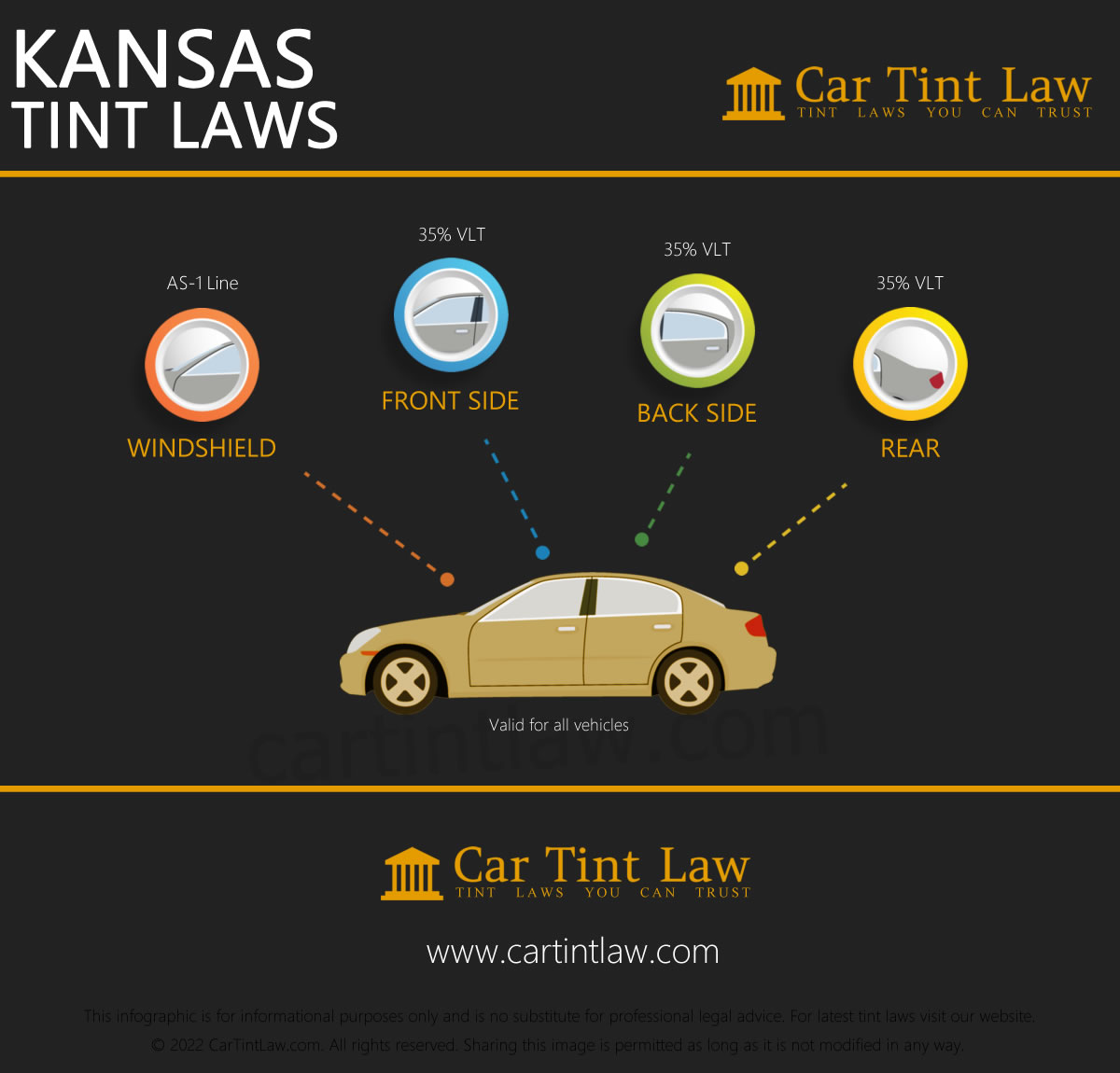Are you planning to get your car windows tinted in Kansas? Before you head to the nearest tint shop, there’s one crucial thing you need to know: Kansas Tint Law.
Navigating the ins and outs of these regulations can feel overwhelming, but understanding them is essential for your peace of mind and ensuring you stay on the right side of the law. Imagine cruising down the highway without worrying about fines or penalties.
By the end of this article, you’ll have a clear understanding of what Kansas Tint Law entails and how it impacts your choices. Keep reading to discover the key details that could save you time, money, and hassle.
Overview Of Kansas Tint Law
Driving through Kansas with tinted windows might seem like a cool idea, especially when the sun’s rays are unrelenting. But before you hit the road, it’s crucial to understand the state’s tint laws. Knowing these regulations not only keeps you legal but also ensures your safety.
What Is Window Tinting?
Window tinting involves adding a thin film to your car’s windows. This film reduces glare and heat, creating a more comfortable driving experience. Yet, the degree of tinting varies, and understanding what’s acceptable in Kansas is essential.
Purpose Of Tint Regulations
Why does Kansas care about window tinting? The main goal is safety. Excessively dark tints can obscure visibility, both for the driver and law enforcement officers. By regulating tint levels, the state ensures everyone can see clearly and interact safely.
Think about it: If an officer can’t see into your car, they might feel uneasy during a traffic stop. Wouldn’t you prefer a relaxed interaction instead of a tense one?
Moreover, specific tint levels help in identifying vehicles and enhancing public safety. No one wants to be in a situation where a misunderstanding arises because of tinted windows. So, how do you ensure your car complies with these laws?
First, familiarize yourself with the percentages allowed on different windows. Kansas has precise requirements that vary for front and rear windows. For instance, front side windows must allow more light compared to rear ones.
Consider visiting a professional tinting service familiar with Kansas regulations. They can guide you on choosing the right tint level. Have you ever been stopped due to window tint? Share your experience, and let’s discuss how you resolved it.
Legal Limits For Tinting
Kansas tint law regulates the darkness of window tints on vehicles. Front side windows must allow over 35% of light. Rear windows and the back can have darker tints, but visibility is still essential for safety. Knowing these limits helps avoid penalties and ensures compliance.
When you’re considering tinting your car windows in Kansas, understanding the legal limits is crucial. Not only does it ensure you’re on the right side of the law, but it also helps you make informed decisions about the level of privacy and sun protection you desire. Let’s dive into the specifics of Kansas tint law, focusing on the key aspects you need to know.Visible Light Transmission (vlt) Requirements
In Kansas, the amount of light that must pass through your window tint is strictly regulated. The state mandates that for passenger cars, the front side windows must allow more than 35% of visible light to pass through. This means you can’t go too dark on your front windows if you want to stay compliant. For the back side and rear windows, you’re allowed to go darker. The law permits any tint darkness, which gives you more freedom to enhance privacy or block out sunlight. However, the windshield must remain clear except for the top few inches, where a non-reflective tint strip is allowed. Choosing a tint that adheres to these VLT requirements not only keeps you legal but also ensures optimal visibility and safety while driving. Have you ever been pulled over for something you thought was minor, like window tint? It’s always better to be safe than sorry.Restrictions On Reflective Tints
Kansas law also sets specific restrictions on reflective tints. Reflective tints can make your car look sleek, but there’s a limit to how much reflectivity is allowed. For both front side and back side windows, the reflection must not be more than 20%. This means you can’t have those highly mirrored windows that you might see on some vehicles. A reflective tint that exceeds this limit can result in fines and the hassle of having to replace it. While reflective tints can reduce glare from the sun, they can also create visibility issues for other drivers. Imagine driving towards a car with a mirror-like tint reflecting the sun straight into your eyes. Not a pleasant experience, right? Understanding these restrictions helps you make better choices and avoid unnecessary penalties. It also keeps your car looking stylish while maintaining safety for yourself and others on the road. By knowing these legal limits and adhering to them, you ensure that your vehicle is both stylish and compliant. Why risk penalties when you can enjoy both privacy and legality by staying informed?Vehicle Categories And Specific Rules
Kansas tint laws vary by vehicle type. Each category has specific rules. Understanding these can help avoid fines. Whether you drive a car, SUV, or a commercial vehicle, know the rules. This ensures compliance with state laws.
Passenger Cars
Passenger cars have clear tint rules. The front side windows must allow more light. At least 35% of light should pass through. The back side and rear windows can be darker. This offers more privacy. These rules ensure safety for drivers and passengers.
Suvs And Vans
SUVs and vans have different rules. Front windows need 35% light transmission. Rear and back windows can be darker. This provides flexibility for owners. Compliance keeps you on the right side of the law.
Commercial Vehicles
Commercial vehicles have specific regulations. Front windows must let in more light. At least 70% light transmission is required. This ensures better visibility. Rear windows can be darker. Safety is the priority for commercial vehicle laws.

Credit: windowstintlaw.com
Exceptions And Special Permissions
The Kansas Tint Law sets clear rules for window tinting. Yet, certain situations call for exceptions and special permissions. These ensure safety and health needs are met. Understanding these can help you comply with the law better.
Medical Exemptions
Some individuals require special tint levels for medical reasons. The law allows exemptions for specific health conditions. A doctor must provide a documented recommendation. This document should specify the need for increased tint. It must be presented when requested by authorities.
Medical exemptions are not automatic. They require careful consideration and validation. Only individuals with documented needs can benefit. This ensures fairness and adherence to the law.
Official Vehicles
Official vehicles often have different tint needs. Law enforcement and emergency vehicles may use darker tints. This helps in ensuring privacy and safety during operations. Government vehicles may also qualify for special permissions.
The tint levels for these vehicles differ from regular ones. They serve specific purposes crucial for their functions. Knowing these exceptions is important for understanding overall tint regulations.
Enforcement And Penalties
Understanding Kansas tint law is crucial for car owners. Enforcement and penalties play a significant role in compliance. Knowing the rules helps avoid trouble with authorities. It’s not just about aesthetics. Safety and legality matter too.
Law Enforcement Procedures
Police use specialized tools to measure window tint. They check if the tint complies with legal limits. Officers may stop vehicles with suspiciously dark windows. They ensure everyone follows the law. Cooperation during these checks is essential. It makes the process smoother for all.
Consequences Of Violations
Violating tint laws can lead to fines. Repeat offenses may result in increased penalties. You might need to remove or adjust the tint. Non-compliance could affect your driving record. It’s not just about fines. Legal issues can arise from repeated violations.

Credit: kctintworks.net
Recent Updates And Changes
In the ever-evolving landscape of automotive regulations, keeping up with the latest updates can feel like a full-time job. This year, Kansas Tint Law has seen some noteworthy changes that could impact your driving experience and vehicle compliance. Whether you’re a seasoned tint enthusiast or someone just looking to understand how these changes might affect you, this guide will provide clear insights into the recent amendments and their implications.
Amendments To Existing Laws
The Kansas Tint Law has undergone several amendments recently. These changes are aimed at making the roads safer while accommodating modern vehicle designs.
One significant amendment is the adjustment to the permissible window tint levels. The front side windows now allow for a slightly darker tint, which can provide more privacy and reduce glare.
However, the rear windows must adhere to stricter transparency standards, ensuring that law enforcement can see inside the vehicle during routine checks. This change addresses the balance between driver comfort and public safety.
Impact Of New Regulations
These new regulations could impact your daily driving routine. If your vehicle’s tint doesn’t comply with the updated laws, you might face fines or the need to remove existing tint.
On the positive side, the law allows you to enjoy a cooler car interior during those scorching Kansas summers. A compliant tint can effectively block harmful UV rays, protecting your skin and vehicle’s upholstery.
Are you considering updating your vehicle’s tint? It’s crucial to ensure that any modifications align with the new regulations. Doing so not only keeps you legal but also enhances your driving comfort and safety.
Engaging with these changes might prompt questions about the state’s priorities. Why focus on tint laws? Are these changes truly beneficial for road safety? Your thoughts and experiences matter in this ongoing conversation about automotive regulations.
Tips For Complying With Tint Laws
Kansas tint law requires front side windows to allow over 35% light in. Check rear windows for different rules. Always carry tint compliance proof in your vehicle.
Navigating the Kansas tint law can seem tricky, but complying with it is essential to avoid fines and ensure safety. Whether you’re considering tinting your car windows for the first time or updating existing tints, understanding the law’s requirements is crucial. By following these tips, you can ensure your vehicle meets legal standards while keeping your ride stylish and cool.Choosing The Right Tint
Selecting the correct tint for your car windows is a vital step. Kansas law specifies different levels of tint for various windows, so knowing these details can save you headaches down the road. For example, your front side windows must allow more than 35% of light in, while the back side windows can be darker. Choose a tint that not only complies with these regulations but also suits your personal taste and needs. If you’re unsure, consider visiting a local auto shop for samples. They often have a variety of shades that meet legal requirements and can help you visualize the difference. Remember, choosing a compliant tint doesn’t mean sacrificing style or comfort. There are many options that offer UV protection and privacy without breaking the law.Consulting Professionals
Sometimes, it’s best to consult professionals when dealing with tint laws. Auto shops specializing in window tints have the expertise to guide you in selecting the right tint and installing it correctly. They can ensure your tinting process complies with Kansas law, avoiding any potential penalties. Having a professional install your tint guarantees precision, which can be crucial for meeting legal standards. Moreover, professionals can offer insights into the latest tinting technologies, like ceramic tints, which provide excellent heat reduction and clarity. You can ask them questions about maintenance and durability, giving you peace of mind and confidence in your choice. Have you ever considered how your window tint impacts your driving experience? Ensuring compliance not only avoids fines but also enhances safety. Knowing your tint won’t obstruct your vision is a reassuring thought every time you hit the road. By choosing the right tint and consulting with professionals, you safeguard your vehicle and yourself, while enjoying the benefits of a tinted ride.
Credit: www.cartintlaw.com
Frequently Asked Questions
What Is The Darkest Legal Tint In Kansas?
In Kansas, the darkest legal tint is 35% VLT for front side windows. Rear windows and back windshield can have any darkness. Ensure compliance with local regulations to avoid penalties.
In What State Is 20% Tint Legal?
20% tint is legal in Arkansas, California, Colorado, Florida, Georgia, Hawaii, Idaho, Illinois, Indiana, Iowa, Kansas, Kentucky, Louisiana, Maryland, Michigan, Mississippi, Missouri, Montana, Nebraska, New Hampshire, New Jersey, New Mexico, North Carolina, Ohio, South Dakota, Tennessee, Texas, Vermont, Virginia, Washington, and Wisconsin.
Always check local laws.
Can You Still See Through 20% Tint?
Yes, you can see through 20% tint, but it is darker compared to lighter tints. Visibility may decrease, especially at night or in low-light conditions. Many people choose 20% tint for privacy while maintaining some visibility.
Do People Get Pulled Over For 20% Tint?
Yes, drivers can be pulled over for having 20% tint if it violates state laws. Tint regulations vary by location, and police enforce them to ensure safety and visibility. It’s important to check local tint laws to avoid penalties and ensure compliance.
Conclusion
Understanding Kansas tint law keeps your vehicle compliant and avoids fines. It’s crucial for safety and legal reasons. The law specifies tint darkness and reflectivity limits. Knowing these guidelines helps you make informed decisions. Always check updates to stay within legal limits.
Local professionals can assist with compliant installations. Protect yourself and others while ensuring your vehicle looks great. Remember, a well-informed driver is a safe driver. Stay informed, stay safe, and enjoy your ride legally. Kansas has specific rules, and following them is important.
Make your driving experience pleasant and worry-free.
